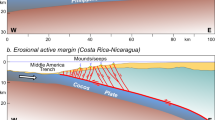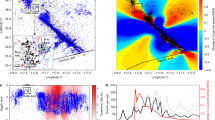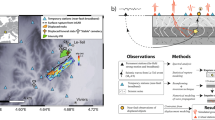Abstract
AFTERSHOCKS of large earthquakes tend to occur close to the main rupture zone, and can be used to constrain its dimensions. But following the 1992 Landers earthquake (magnitude Mw = 7.3) in southern California, many aftershocks were reported1 in areas remote from the mainshock. Intriguingly, this remote seismicity occurred in small clusters near active volcanic and geothermal systems. For one of these clusters (Long Valley, about 400 km from the Landers earthquake), crustal deformation associated with the seismic activity was also monitored. Here we argue that advec-tive overpressure2–7 provides a viable mechanism for remote seismicity triggered by the Landers earthquake. Both the deformation and seismicity data are consistent with pressure increases owing to gas bubbles rising slowly within a volume of magma. These bubbles may have been shaken loose during the passage of seismic waves generated by the mainshock.
This is a preview of subscription content, access via your institution
Access options
Subscribe to this journal
Receive 51 print issues and online access
$199.00 per year
only $3.90 per issue
Buy this article
- Purchase on Springer Link
- Instant access to full article PDF
Prices may be subject to local taxes which are calculated during checkout
Similar content being viewed by others
References
Hill, D. P. et al. Science 260, 1617–1623 (1993).
Shteynberg, G., Shteynberg, A. & Merzhanov, A. Dokl. Akad. Nauk SSSR 299, 1081–1086 (1984).
Steinberg, G., Steinberg, A. & Merzhanov, A. Mod. Geol. 13, 257–265 (1989).
Steinberg, G., Steinberg, A. & Merzhanov, A. Mod. Geol. 13, 267–274 (1989).
Steinberg, G., Steinberg, A. & Merzhanov, A. Mod. Geol. 13, 274–285 (1989).
Sahagian, D. L. & Proussevitch, A. A. Nature 359, 485 (1992).
Sahagian, D. L. Nature 361, 308 (1993).
Langbein, J., Hill, D. P., Parker, T. N. & Wilkenson, S. K. J. geophys. Res. 98, 15851–15870 (1993).
Sacks, I. S., Suyehiro, S., Evertson, D. W. & Yamagishi, Y. Pap. Met. Geophys. 22, 195–208 (1971).
Beavan, J. U. S. Geol. Surv. Open-File Rep. 91-352, 225–228 (1991).
Bodin, P. & Gomberg, J. Bull. seism. Soc. Am. 84, 835–843 (1994).
Gomberg, J. & Bodin, P. Bull. seism. Soc. Am. 84, 844–853 (1994).
Anderson, J. G. et al. Bull. seism. Soc. Am. 84, 863–891 (1994).
Anderson, A. T. et al. Geology 17, 221–225 (1990).
Pitt, A. M. & Hill, D. P. Geophys. Res. Lett. 21, 1679–1682 (1994).
Gerlach, T. M., Westrich, H. R. & Symonds, R. B. Prof. Pap. U.S. geol. Surv. (in the press).
Ryan, M. P. & Blevins, J. Y. K. Bull. U.S. Geol. Surv. 1764, (1987).
Bailey, R. A., Dalrymple, G. B. & Lanphere, M. A. J. geophys. Res. 81, 725–744 (1976).
Thomas, N., Tait, S. & Koyaguchi, T. Earth planet. Sci. Lett. 115, 161–175 (1993).
Sorey, M. L., Kennedy, B. M., Evans, W. C., Farrar, C. D. & Suemnicht, G. A. J. geophys. Res. 98, 15871–15889 (1993).
Author information
Authors and Affiliations
Rights and permissions
About this article
Cite this article
Linde, A., Sacks, I., Johnston, M. et al. Increased pressure from rising bubbles as a mechanism for remotely triggered seismicity. Nature 371, 408–410 (1994). https://doi.org/10.1038/371408a0
Received:
Accepted:
Issue Date:
DOI: https://doi.org/10.1038/371408a0
This article is cited by
-
Activated volcanism of Mount Fuji by the 2011 Japanese large earthquakes
Scientific Reports (2023)
-
Volcanic eruptions are triggered in static dilatational strain fields generated by large earthquakes
Scientific Reports (2021)
-
A review framework of how earthquakes trigger volcanic eruptions
Nature Communications (2021)
-
New observations in Central Italy of groundwater responses to the worldwide seismicity
Scientific Reports (2020)
-
Effective time- and frequency-domain techniques for interpreting seismic precursors in groundwater level fluctuations on Jeju Island, Korea
Scientific Reports (2020)
Comments
By submitting a comment you agree to abide by our Terms and Community Guidelines. If you find something abusive or that does not comply with our terms or guidelines please flag it as inappropriate.



